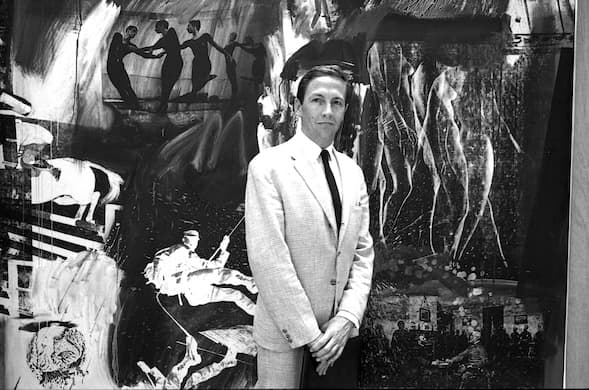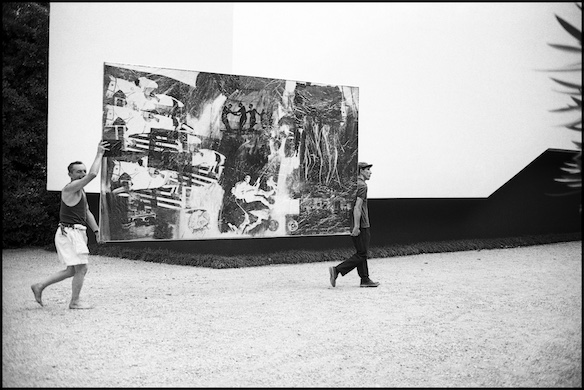For Some, the Good Stuff in New Documentary About the ‘Olympics of Arts’ May Be Too Buried To Find
Trim 30 minutes from ‘Taking Venice’ and you’d have a solid one-hour special tailor-made for PBS. Otherwise, only art world cognoscenti will get much traction from this assemblage.

A documentary by arts writer Amei Wallach, “Taking Venice,” is never as arresting or as rewarding as it is during the final credits. After laying out the story of an American plot to establish cultural hegemony during the Cold War, the film ends with a Louis Armstrong song titled “Cultural Exchange.”
Written by Dave and Iola Brubeck, the tune is culled from “The Real Ambassadors” (1961), a musical revue that placed a sardonic eye on the Department of State’s program of sending jazz musicians abroad as a means of fostering American democracy. That those same performers, the majority of whom were Black Americans, encountered discrimination back home was an irony not lost on its participants. It certainly wasn’t lost on Satchmo.
Pegged as the first jazz ambassador to travel overseas, Armstrong turned down the position after the Eisenhower administration failed to enforce school integration at Little Rock, Arkansas. “The way they are treating my people in the South, the government can go to hell,” he declared.
Armstrong eventually did participate in the program, but his ire wasn’t waylaid. A delicious current of sarcasm is abundant as Armstrong chews his way through lyrics like “The State Department has discovered jazz/It reaches folks like nothin’ ever has!/Like when they feel that jazzy rhythm/They know we’re really with ’em.”
“Cultural Exchange” is a very funny song and a welcome find. Yet there’s an equally cogent and shocking fact disclosed to the audience at the backend of “Taking Venice”: We learn from one of many concluding intertitles that Robert Rauschenberg — an American artist black-balled from the Venice Biennale after winning the 1964 Grand Prize in Painting — was invited back to Serenissima a quarter of a century later at the behest of … the Soviet Union.

Talk about burying the lede. What kind of skullduggery went on in this game of international one-upmanship? By 1990, the soft-spoken Neo-Dadaist of Port Arthur, Texas, had become among the most lauded, most famous, and most privileged of neo-Dadaists. No starving artist, he: By the time of his death at age 82 in 2008, Rauschenberg’s net worth was in the hundreds of millions of dollars. How this happy capitalist and cultural gadfly became a poster boy for the USSR is a story worthy of Gogol.
Not that the tale of an American — really, Northeast corridor — art cartel doesn’t have its own diversions. Since its inception in 1895, the Venice Biennale has been considered the “Olympics of Art,” an event in which nations from around the globe send what are purportedly their best artists. Reputations, careers, and bragging rights are made at this biannual expo; money, too. Rauschenberg was taken aback by the resulting notoriety: “I had moments where I thought everything would be much better if I hadn’t been so lucky.”
Luck had nothing to do with it. A connivance of power brokers — primarily, the Jewish Museum curator, Alan Solomon; a society doyenne, Alice Denney, and a smooth-as-silk art world macher, Leo Castelli — wheeled, dealed, and skulked their way through the requisite campos to guarantee that Rauschenberg was the first American to win top honors at the Biennale. The foreign press was aghast when the judgment came down. A taxidermied goat encased by a rubber tire? The purest imperialism, red, white, and blue.
Ms. Wallach’s tale of intrigue gets side-tracked by explaining, and then re-explaining, why Rauschenberg was some kind of genius. A good espionage tale shouldn’t need overcompensating, uncritical baggage: Hagiography, we can do without. Trim 30 minutes from “Taking Venice” and you’d have a solid one-hour special tailor-made for PBS. Otherwise, only art world cognoscenti will get much traction from this assemblage — I’m sorry, “combine” — of a documentary.

